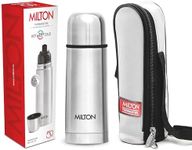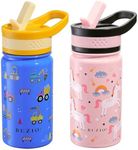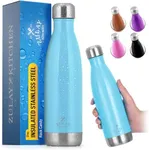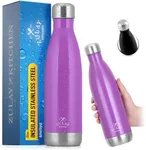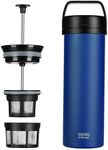Buying Guide for the Best Hot Water Flasks
Choosing the right hot-water flask can make a big difference in your daily routine, whether you're using it for keeping your coffee hot during a long commute, or for keeping water warm during a camping trip. The key is to understand the different specifications and how they align with your needs. Here are some important factors to consider when selecting a hot-water flask.CapacityCapacity refers to the amount of liquid the flask can hold, usually measured in liters or milliliters. This is important because it determines how much hot water you can carry with you. Smaller flasks (around 300-500ml) are great for personal use and short trips, while larger flasks (1-2 liters) are better for sharing or longer outings. Choose a capacity based on how much liquid you need to keep hot and how portable you need the flask to be.
InsulationInsulation is what keeps the liquid inside the flask hot (or cold) for extended periods. There are two main types: vacuum insulation and foam insulation. Vacuum insulation is generally more effective and can keep liquids hot for up to 24 hours, making it ideal for long trips or all-day use. Foam insulation is less effective but can still keep liquids hot for several hours, which might be sufficient for shorter durations. Consider how long you need your drink to stay hot when choosing the type of insulation.
MaterialThe material of the flask affects its durability, weight, and heat retention. Stainless steel is the most common material because it is durable, resistant to rust, and has good heat retention properties. Plastic flasks are lighter and cheaper but may not keep liquids hot as long and can be less durable. Glass flasks offer excellent heat retention and are easy to clean but are more fragile. Choose a material based on your priorities for durability, weight, and heat retention.
Lid TypeThe lid type can influence the ease of use and heat retention of the flask. Screw-top lids are very secure and good for preventing leaks, but they can be a bit cumbersome to open and close frequently. Flip-top lids are more convenient for quick access but may not be as leak-proof. Some flasks come with a cup integrated into the lid, which can be handy for drinking on the go. Think about how you will be using the flask and choose a lid type that matches your needs for convenience and security.
PortabilityPortability is about how easy it is to carry the flask around. This includes the size and weight of the flask, as well as any additional features like handles or straps. Smaller, lighter flasks are easier to carry in a bag or by hand, making them ideal for commuting or short trips. Larger flasks might come with handles or shoulder straps to make them easier to carry. Consider how and where you will be using the flask to determine the right level of portability for you.
Ease of CleaningEase of cleaning is an important factor to consider, especially if you plan to use the flask frequently. Flasks with wide mouths are generally easier to clean because you can reach inside with a brush. Some flasks are also dishwasher safe, which can save time and effort. If hygiene is a priority for you, look for a flask that is easy to disassemble and clean thoroughly.







